Energy Dissipation in Stepped Spillways with Different Horizontal Face Angles
Abstract
1. Introduction
2. Numerical Model
2.1. Layout of the Numerical Model
2.2. Governing Equations
2.3. Boundary Conditions and Solver
2.4. Validation Model
3. Results and Discussion
3.1. Streamlines
3.2. Energy Dissipation Rate
3.3. Turbulence Kinetic Energy (k) and Its Dissipation Rate (ε)
4. Conclusions
- (1)
- The fluctuation of a free water surface will be larger with the larger absolute values of the angles in the V shaped stepped spillway. The fluctuations will be higher in the vicinity of the axial plane or sidewalls for θ > 0° or θ < 0°.
- (2)
- The energy dissipation rate increases with the absolute values of the horizontal face angles and decreases as the unit discharge increases. The energy dissipation rate of the traditional stepped spillway is the minimum in all kinds of stepped spillways.
- (3)
- The flow field and the flow direction can be changed by the horizontal face angles of the stepped spillway, which produces some unique characteristics, such as unique vortex structures, which can cause better energy dissipation. These results will be useful in choosing a better stepped spillway for energy dissipation.
Author Contributions
Funding
Conflicts of Interest
Nomenclature
| B | model width |
| g | acceleration of gravity |
| GCI | Grid convergence index |
| H | height of the step |
| i | number of Grid in GCI |
| k | turbulence kinetic energy |
| L | length of the step |
| P | pressure |
| q | unit discharge |
| t | time |
| v | velocity |
| X | distance of the pressure detecting point on horizontal surface from the step’s inner edge |
| Y | distance of the pressure detecting points on vertical surface from the step’s lower edge |
| C2 | empirical constant |
| 0.09 | |
| 1.44 | |
| 1.92 | |
| E1 | total energy in the first step of a stepped section |
| E2 | the total energy at a section below the stepped section |
| turbulent energy caused by average velocity gradient | |
| turbulent energy caused by lift force | |
| hi | grid size in GCI |
| kmax | maximum turbulence kinetic energy |
| user-defined source item | |
| user-defined source item | |
| ui | mean velocity component in the ith direction |
| average velocities in the first step of a stepped section | |
| average velocities in a section below the stepped section | |
| contribution of compressible turbulent fluctuation expansion to overall dissipation rate | |
| ε | turbulence dissipation rate |
| μ | dynamic viscosity |
| θ | horizontal face angle |
| η | energy dissipation rate |
| ρ | mean density |
| densities of air | |
| densities of water | |
| volume fraction of water | |
| εmax | maximum turbulence dissipation rates |
| viscosities of air | |
| viscosities of water | |
| empirical constant,1.0 | |
| empirical constant | |
| solution about the ith grid | |
| difference in height between two sections | |
| ΔE | difference in energy between two sections |
References
- Anwar, N.; Dermawan, V. Physical hydraulic model investigation of flow and energy dissipation on smooth and stepped spillway with steep slope. Int. J. Acad. Res. 2011, 3, 727. [Google Scholar]
- Felder, S.; Chanson, H. Energy dissipation down a stepped spillway with non-uniform step heights. J. Hydraul. Eng. 2011, 137, 1543–1548. [Google Scholar] [CrossRef]
- Morovati, K.; Eghbalzadeh, A.; Soori, S. Numerical study of energy dissipation of polled stepped spillways. Civ. Eng. J. 2016, 2, 208–220. [Google Scholar] [CrossRef]
- Chanson, H. Comparison of energy dissipation between nape and skimming flow regimes on stepped chutes. J. Hydraul. Res. 1994, 32, 213–218. [Google Scholar] [CrossRef]
- Abbasi, S.; Kamanbedast, A.A. Investigation of Effect of Changes in Dimension and Hydraulic of Stepped Spillways for Maximization Energy Dissipation. World Appl. Sci. J. 2012, 18, 261–267. [Google Scholar]
- Rassaei, M.; Rahbar, S. Numerical flow model stepped spillways in order to maximize energy dissipation using FLUENT software. IOSR J. Eng. 2014, 4, 17–25. [Google Scholar] [CrossRef]
- Tabari, M.M.R.; Tavakoli, S. Effects of stepped spillway geometry on flow pattern and energy dissipation. Arab. J. Sci. Eng. 2016, 41, 1215–1224. [Google Scholar] [CrossRef]
- Wu, P.; Wang, B.; Chen, Y.L.; Zhou, Q. Energy Dissipation of Skimming Flow over Stepped Chutes with Different Slopes. J. Sichuan Univ. 2012, 44, 24–29. (In Chinese) [Google Scholar]
- Shahheydari, H.; Nodoshan, E.J.; Barati, R.; Moghadam, M.A. Discharge coefficient and energy dissipation over stepped spillway under skimming flow regime. KSCE J. Civ. Eng. 2015, 19, 1174–1182. [Google Scholar] [CrossRef]
- Attarian, A.; Hosseini, K.; Abdi, H.; Hosseini, M. The effect of the step height on energy dissipation in stepped spillways using numerical simulation. Arab. J. Sci. Eng. 2014, 39, 2587–2594. [Google Scholar] [CrossRef]
- Zhang, Z.C.; Zeng, D.Y.; Liu, Y.F. Expermiental Research on the Presented Water-Surface Curve of Skmiming Flow on Stepped Spillways and Energy Disspation. Chin. J. Appl. Mech. 2005, 22, 30–36. (In Chinese) [Google Scholar]
- Guenther, P.; Felder, S.; Chanson, H. Flow aeration, cavity processes and energy dissipation on flat and pooled stepped spillways for embankments. Environ. Fluid Mech. 2013, 13, 503–525. [Google Scholar] [CrossRef]
- Mero, S.; Mitchell, S. Investigation of energy dissipation and flow regime over various forms of stepped spillways. Water Environ. J. 2016, 31, 127–137. [Google Scholar] [CrossRef]
- Barani, G.A.; Rahnama, M.B.; Sohrabipoor, N. Investigation of flow energy dissipation over different stepped spillways. J. Phys. Chem. C 2005, 117, 7123–7137. [Google Scholar]
- Jahad, U.A.; Al-Ameri, R.; Das, S. Energy dissipation and geometry effects over stepped spillways. Int. J. Civ. Eng. Technol. 2016, 7, 188–198. [Google Scholar]
- Tian, Z.; Xu, W.L.; Yu, T.; Zhou, H.H.; Xiao, F.R. Characteristics of Energy Dissipation for V shaped Stepped Spillway. J. Sichuan Univ. 2010, 42, 21–25. (In Chinese) [Google Scholar]
- Shih, T.H.; Liou, W.W.; Shabbir, A.; Yang, Z.; Zhu, J. A new k-ε eddy viscosity model for high Reynolds number turbulent flows. Comput. Fluids 1995, 24, 227–238. [Google Scholar] [CrossRef]
- Qian, Z.D.; Hu, X.Q.; Huai, W.X.; António, A. Numerical simulation and analysis of water flow over stepped spillways. Sci. China Technol. Sci. 2009, 52, 1958–1965. (In Chinese) [Google Scholar] [CrossRef]
- Duangrudee, K.; Chaiyuth, C.; Pierre, Y.J. Numerical simulation of flow velocity profiles along a stepped spillway. Inst. Mech. Eng. 2014, 227, 327–335. [Google Scholar]
- Bai, Z.L.; Zhang, J.M. Comparison of different turbulence models for numerical simulation of pressure distribution in v-shaped stepped spillway. Math. Probl. Eng. 2017, 2017, 1–9. [Google Scholar] [CrossRef]
- Celik, I.B.; Ghia, U.; Roache, P.J.; Freitas, C.J. Procedure for estimation and reporting of uncertainty due to discretization in CFD applications. J. Fluids Eng. 2008, 130, 078001. [Google Scholar]
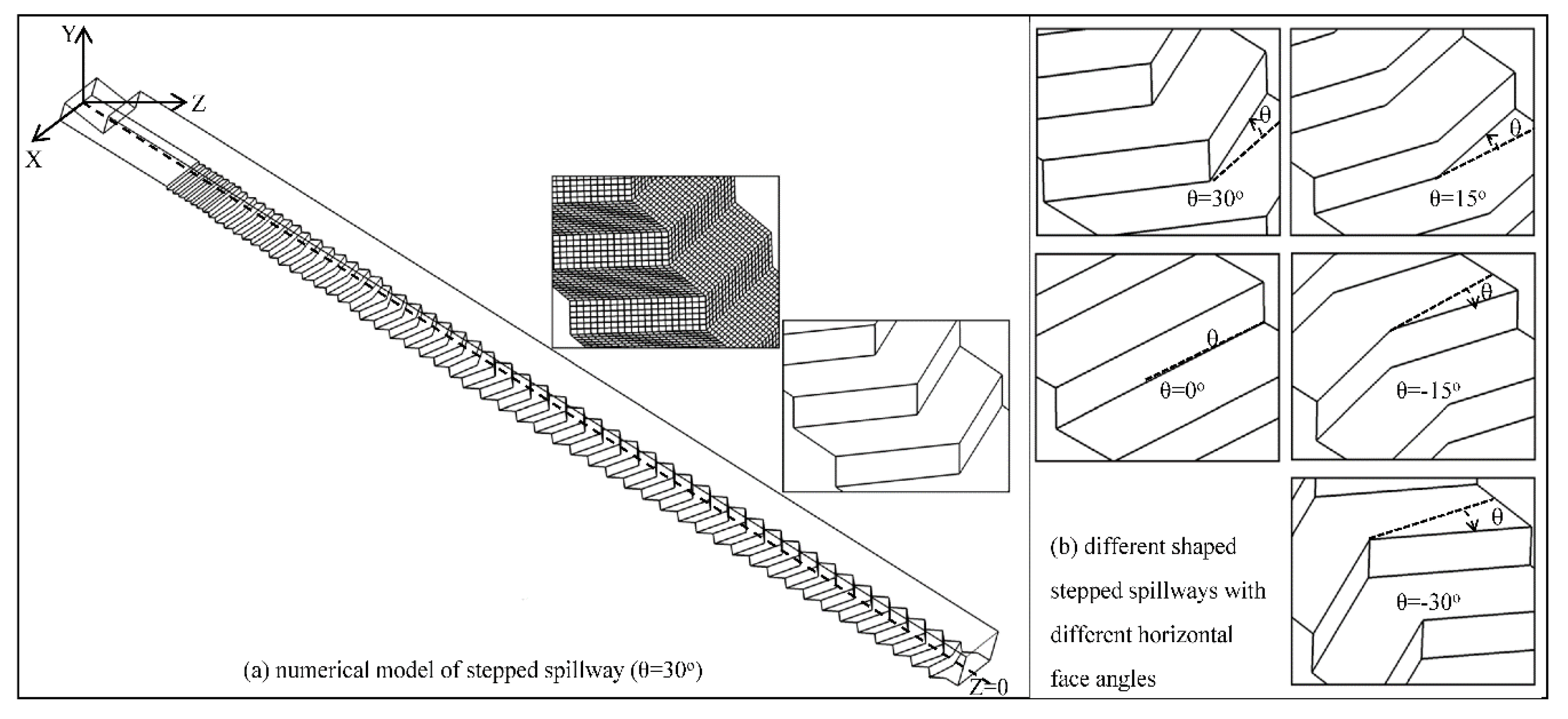
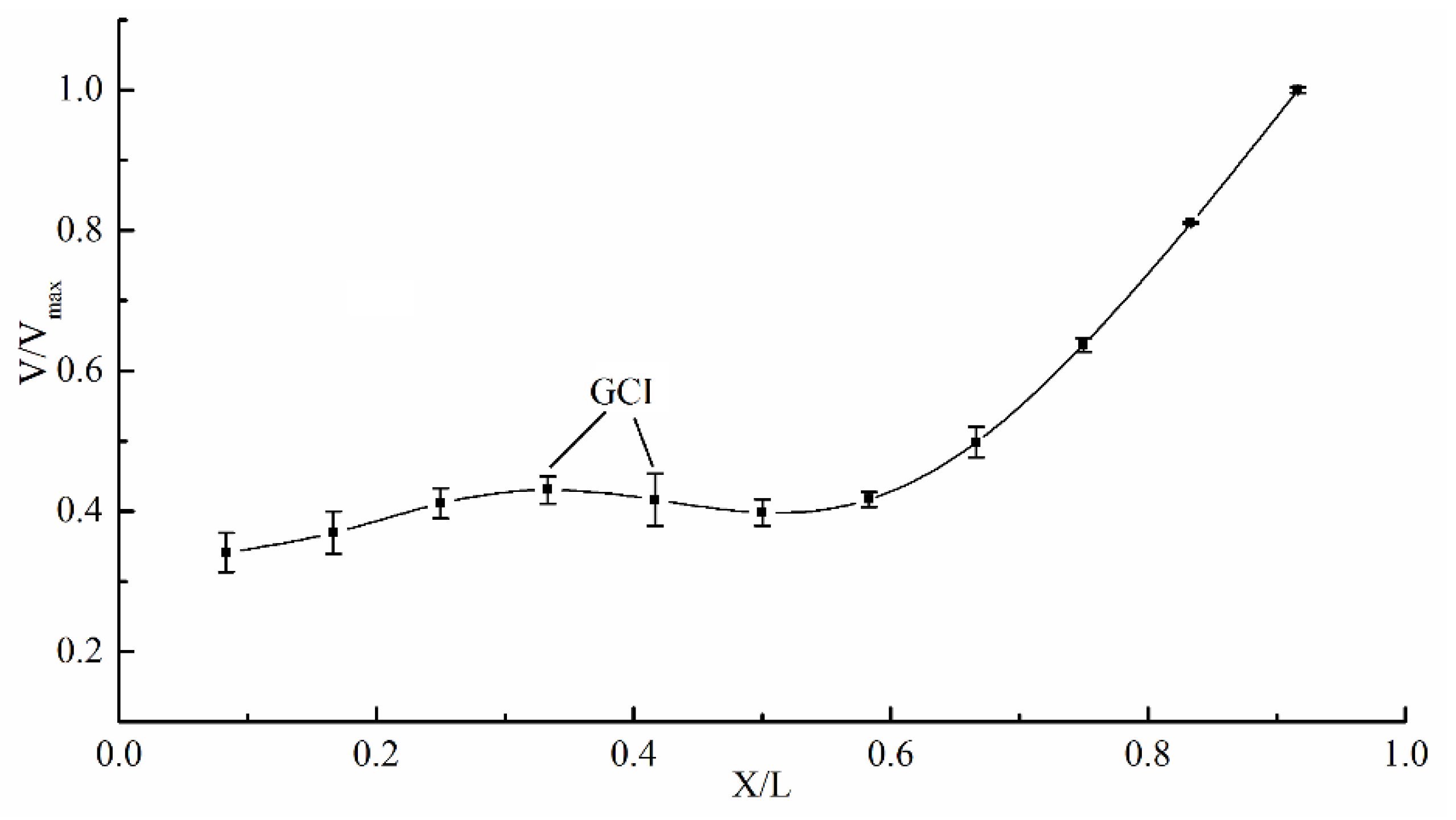

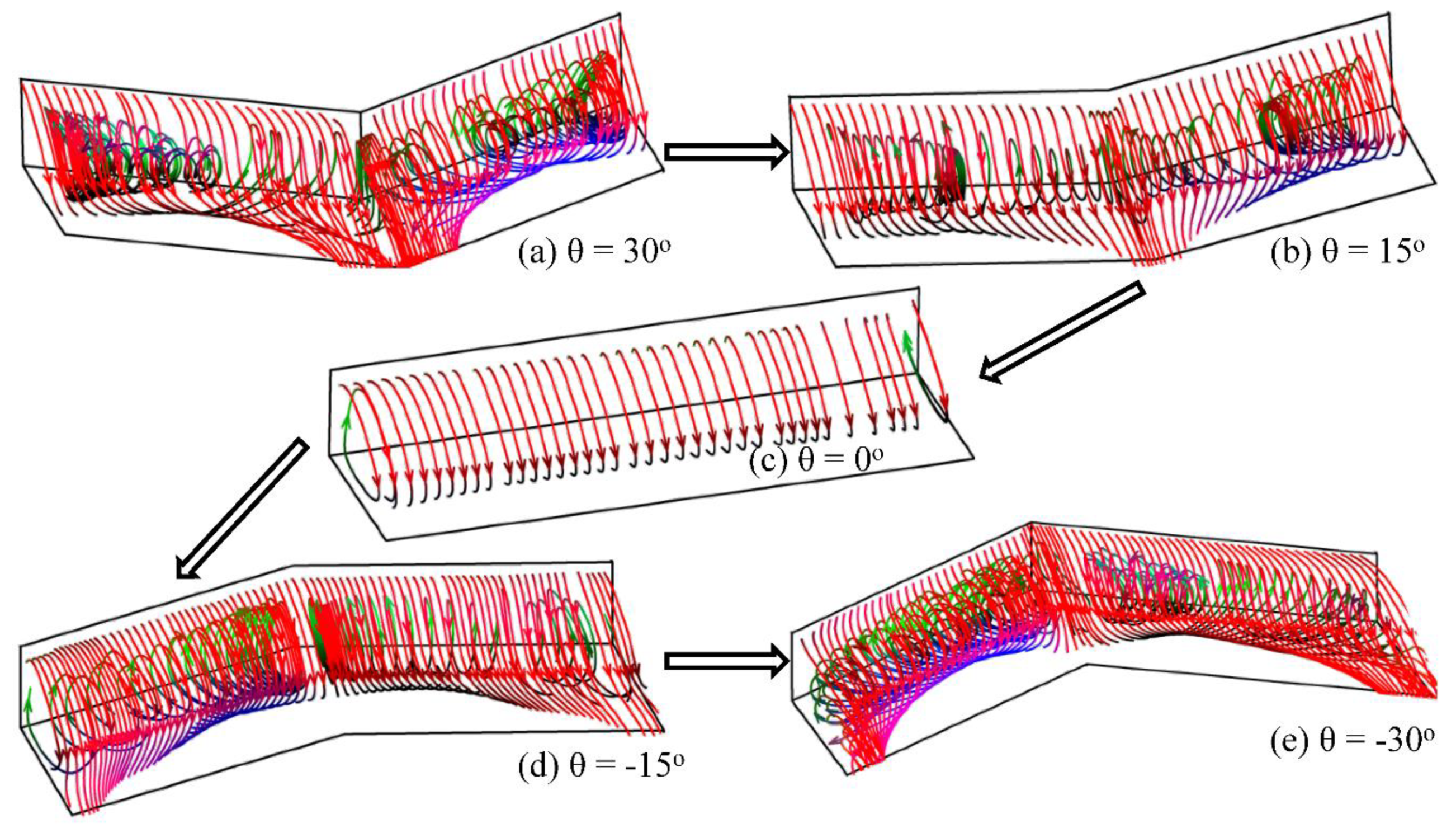
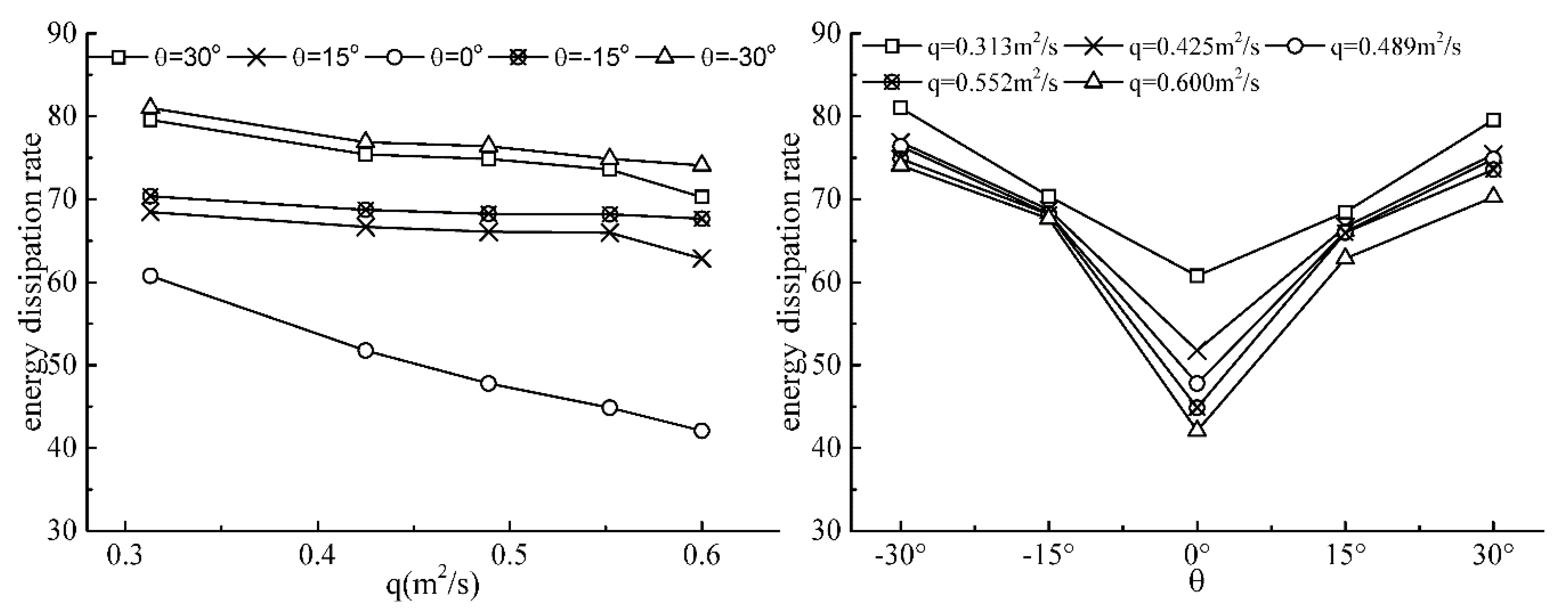
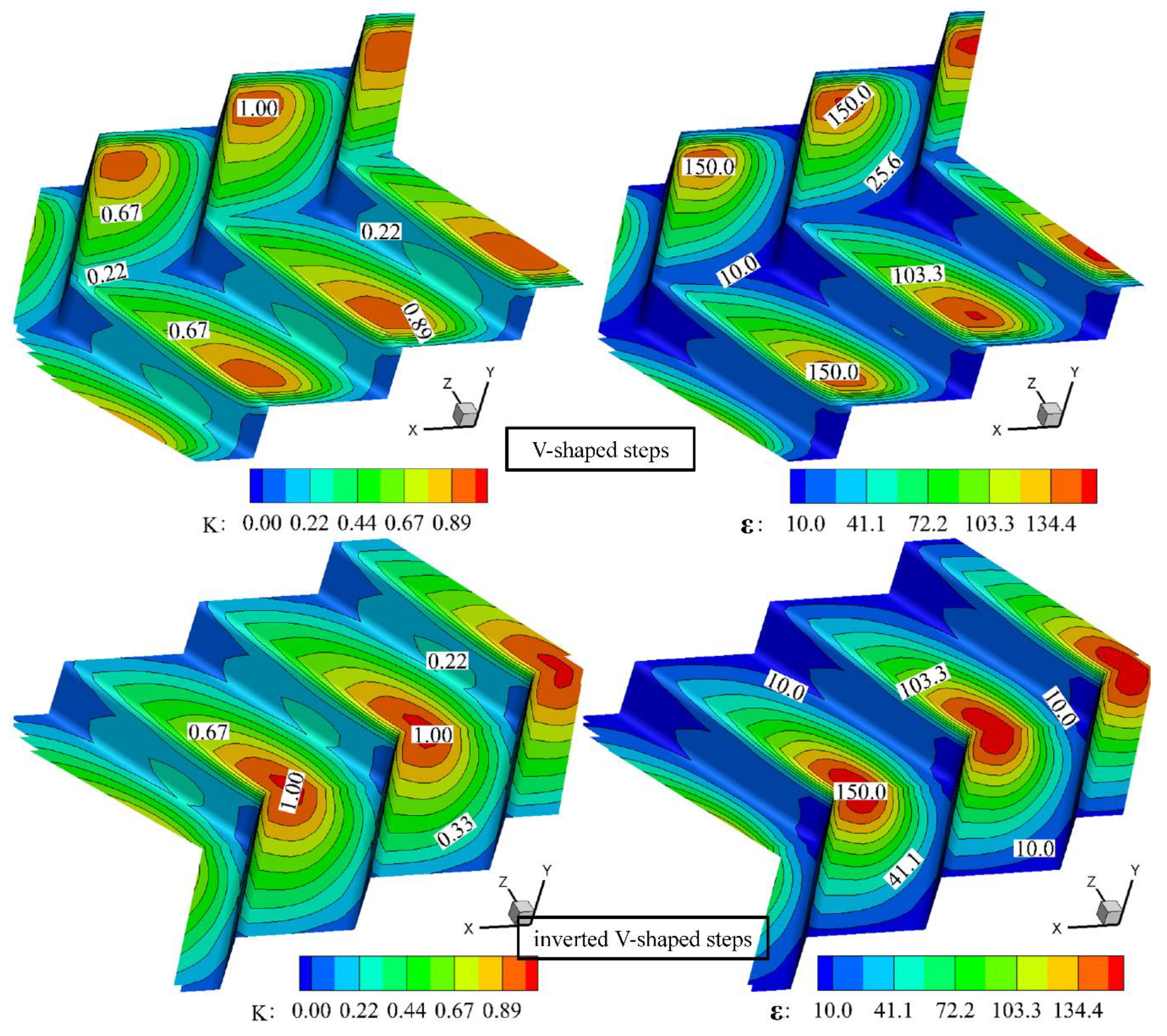

| X/L | X/B = 0 | X/B = 0.25 | X/B = 0.5 | ||||||
|---|---|---|---|---|---|---|---|---|---|
| Physical | Numerical | Error (%) | Physical | Numerical | Error (%) | Physical | Numerical | Error (%) | |
| 0.08 | −7.02 | −7.58 | 7.94 | 8.02 | 8.58 | 6.95 | 13.39 | 13.34 | −0.37 |
| 0.17 | −9.48 | −9.93 | 4.76 | 3.80 | 4.04 | 6.23 | 12.70 | 13.12 | 3.34 |
| 0.25 | −12.72 | −13.18 | 3.56 | 1.40 | 1.46 | 4.15 | 12.80 | 13.11 | 2.43 |
| 0.33 | −15.48 | −14.45 | −6.65 | 3.42 | 3.22 | −5.76 | 14.05 | 13.30 | −5.35 |
| 0.42 | −11.04 | −11.83 | 7.19 | 8.21 | 8.46 | 3.14 | 14.24 | 13.67 | −4.01 |
| 0.50 | −2.20 | −2.37 | 7.45 | 15.08 | 15.23 | 1.03 | 14.99 | 14.09 | −6.01 |
| 0.58 | 11.67 | 12.42 | 6.41 | 22.48 | 21.64 | −3.72 | 15.17 | 14.35 | −5.43 |
| 0.67 | 31.65 | 32.87 | 3.85 | 27.98 | 26.28 | −6.08 | 14.44 | 14.22 | −1.53 |
| 0.75 | 51.92 | 52.66 | 1.41 | 30.63 | 28.53 | −6.86 | 14.57 | 13.65 | −6.30 |
| 0.83 | 61.08 | 63.15 | 3.39 | 31.24 | 28.86 | −7.62 | 13.40 | 12.64 | −5.68 |
| 0.92 | 60.57 | 57.25 | −5.47 | 27.32 | 25.72 | −5.88 | 11.85 | 11.19 | −5.59 |
| Y/H | X/B = 0 | X/B = 0.25 | X/B = 0.5 | ||||||
|---|---|---|---|---|---|---|---|---|---|
| Physical | Numerical | Error (%) | Physical | Numerical | Error (%) | Physical | Numerical | Error (%) | |
| 0.83 | −23.94 | −25.70 | 7.35 | −3.31 | −3.53 | 6.86 | 8.16 | 7.65 | −6.21 |
| 0.67 | −11.58 | −12.33 | 6.54 | −1.49 | −1.55 | 4.35 | 8.68 | 8.49 | −2.14 |
| 0.50 | −10.48 | −11.25 | 7.41 | −2.84 | −2.64 | −7.09 | 8.90 | 9.03 | 1.39 |
| 0.33 | −9.12 | −9.47 | 3.83 | 1.49 | 1.60 | 6.95 | 10.71 | 10.39 | −3.01 |
| 0.17 | −7.61 | −7.26 | −4.48 | 8.95 | 9.56 | 6.82 | 11.92 | 12.37 | 3.70 |
| Case | θ = 30° | ||
|---|---|---|---|
| q(m2/s) | Physical Value | Numerical Value | Error (%) |
| 0.313 | 75.21 | 79.56 | 5.78 |
| 0.425 | 73.21 | 75.39 | 2.98 |
| 0.489 | 70.14 | 74.84 | 6.70 |
| 0.552 | 69.24 | 73.56 | 6.24 |
| 0.600 | 67.76 | 70.24 | 3.66 |
© 2019 by the authors. Licensee MDPI, Basel, Switzerland. This article is an open access article distributed under the terms and conditions of the Creative Commons Attribution (CC BY) license (http://creativecommons.org/licenses/by/4.0/).
Share and Cite
Peng, Y.; Zhang, X.; Yuan, H.; Li, X.; Xie, C.; Yang, S.; Bai, Z. Energy Dissipation in Stepped Spillways with Different Horizontal Face Angles. Energies 2019, 12, 4469. https://doi.org/10.3390/en12234469
Peng Y, Zhang X, Yuan H, Li X, Xie C, Yang S, Bai Z. Energy Dissipation in Stepped Spillways with Different Horizontal Face Angles. Energies. 2019; 12(23):4469. https://doi.org/10.3390/en12234469
Chicago/Turabian StylePeng, Yongqin, Xujin Zhang, Hao Yuan, Xia Li, Chunhang Xie, Shuqing Yang, and Zhaoliang Bai. 2019. "Energy Dissipation in Stepped Spillways with Different Horizontal Face Angles" Energies 12, no. 23: 4469. https://doi.org/10.3390/en12234469
APA StylePeng, Y., Zhang, X., Yuan, H., Li, X., Xie, C., Yang, S., & Bai, Z. (2019). Energy Dissipation in Stepped Spillways with Different Horizontal Face Angles. Energies, 12(23), 4469. https://doi.org/10.3390/en12234469




